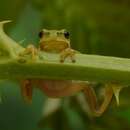en
names in breadcrumbs


Development - Life Cycle: metamorphosis
Other Physical Features: ectothermic ; bilateral symmetry
Key Reproductive Features: gonochoric/gonochoristic/dioecious (sexes separate)
Hylidae is a wide-ranging family of frogs commonly referred to as "tree frogs and their allies". However, the hylids include a diversity of frog species, many of which do not live in trees, but are terrestrial or semiaquatic.
The earliest known fossils that can be assigned to this family are from the Cretaceous of India and the state of Wyoming in the United States.[1]
The common name of "tree frog" is a popular name for several species of the family Hylidae. However, the name "treefrog" is not unique to this family, also being used for many species in the family Rhacophoridae.
The following genera are recognised in the family Hylidae:[2][3][4][5]
The subfamilies Pelodryadinae and Phyllomedusinae are sometimes classified as distinct families of their own due to their deep divergence and unique evolutionary history (with Pelodryadinae being the sister group to Phyllomedusinae and colonizing Australia during the Eocene via Antarctica, which at the time was not yet frozen over), but are presently retained in the Hylidae.[2][6]
Most hylids show adaptations suitable for an arboreal lifestyle, including forward-facing eyes providing binocular vision, and adhesive pads on the fingers and toes. In the nonarboreal species, these features may be greatly reduced, or absent.
The European tree frog (Hyla arborea) is common in the middle and south of Europe, and its range extends into Asia and North Africa.
North America has many species of the family Hylidae, including the gray tree frog (Hyla versicolor) and the American green tree frog (H. cinerea). The spring peeper (Pseudacris crucifer) is also widespread in the eastern United States and is commonly heard on spring and summer evenings.
Species of the genus Cyclorana are burrowing frogs that spend much of their lives underground.[7]
Hylids lay their eggs in a range of different locations, depending on species. Many use ponds, or puddles that collect in the holes of their trees, while others use bromeliads or other water-holding plants. Other species lay their eggs on the leaves of vegetation hanging over water, allowing the tadpoles to drop into the pond when they hatch.[7]
A few species use fast-flowing streams, attaching the eggs firmly to the substrate. The tadpoles of these species have suckers enabling them to hold on to rocks after they hatch. Another unusual adaptation is found in some South American hylids, which brood the eggs on the back of the female. The tadpoles of most hylid species have laterally placed eyes and broad tails with narrow, filamentous tips.[7]
Hylids mostly feed on insects and other invertebrates, but some larger species can feed on small vertebrates.
Dryophytes versicolor, North American gray tree frog
Hyla japonica, Japanese tree frog
{{cite journal}}: Cite journal requires |journal= (help) Hylidae is a wide-ranging family of frogs commonly referred to as "tree frogs and their allies". However, the hylids include a diversity of frog species, many of which do not live in trees, but are terrestrial or semiaquatic.